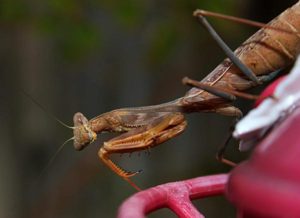 The last of the stragglers have moved on now to their winter homes in South America, but the memory of hummingbirds remains. This year, not necessarily in a good way.
The last of the stragglers have moved on now to their winter homes in South America, but the memory of hummingbirds remains. This year, not necessarily in a good way.
My friend Nancy, who lives in Nashville, often posts about nature on her Facebook wall. In mid-September, she posted a close-up photo of a praying mantis on her feeder. “This ambitious guy has been trying to capture hummingbirds,” she wrote. “I’ve knocked him off twice but he keeps coming back.” What??? I’d never heard of such a thing. I knew that reptiles can snag low-flying hummingbirds. Large, aggressive birds prey upon them, as do squirrels who invade the hummingbird nest and eat the babies. And we all know about cats.
But a praying mantis? Who would have ever thought?
I’ve always considered them endearing insects, with their huge cartoonish eyes and swiveling heads and—best of all—delicate hands that appear to be poised in prayer. As it turns out, those reverent hands are likely praying that their next meal will happen along soon.
Mantises hang out on hummingbird feeders not only to stalk the birds but also because they like to dine on the wasps and bees that come for the sugar water. The good news for the hummingbird lovers among us is that the diminutive birds are an infrequent part of the praying mantis diet, perhaps because they’re too large to finish at one meal. And hummers often put up a fight. Praying mantises prefer more docile fare such as aphids, beetles, crickets, grasshoppers, spiders and butterflies.
If you have the stomach for it, you can watch an impressive number of mantis-on-hummer ambushes on You Tube. Surprise is their usual plan of attack. Praying mantises blend in with their surroundings and can remain very still for a very long time. Combine that with amazing jumping and twisting skills and the ability to stick a landing like Simone Biles and you have a predator that’s hard to overcome.
A praying mantis has no venom and thus must kill by quickly and severely wounding its prey. It will lurk on or near a feeder and watch intently as a hummingbird hovers close to the nectar. Then, with a swift swipe of its forelegs, which are endowed with sharp spikes, it will impale the bird and begin to eat while it’s still alive and struggling. Though the mantis will consume meat from the hummingbird’s chest, it prefers to chew through the skull and feast on the brain. It’s truly the stuff of which horror movies are made.
So how do you keep this carnage from happening in your own back yard? First, decide whether you want to prevent it. Praying mantises are prized by many gardeners not only because they’re adorable but also because they eat insect pests. Perhaps the sacrifice of a few hummingbirds over the course of a summer is a small price to pay for having mantises around.
But if you want to protect your hummers, be sure to place feeders a good distance away from shrubs and trees. Immediately remove and relocate any mantises you discover on or near the feeder. This didn’t work for Nancy. No sooner had she carried her mantis off than it (or one that looked just like it) was back. I’ve read stories of folks who claim to have captured aggressive praying mantises and carted them off to another neighborhood, though that seems somewhat extreme. You can try taking feeders down for a few days to encourage the mantises to seek food elsewhere, though that might also encourage your hummingbirds to do likewise.
Probably the simplest and wisest thing to do is to accept that nature is beautiful but brutal. Prey becomes predator. Predator becomes prey. And the circle of life goes on.
(October 9, 2021)